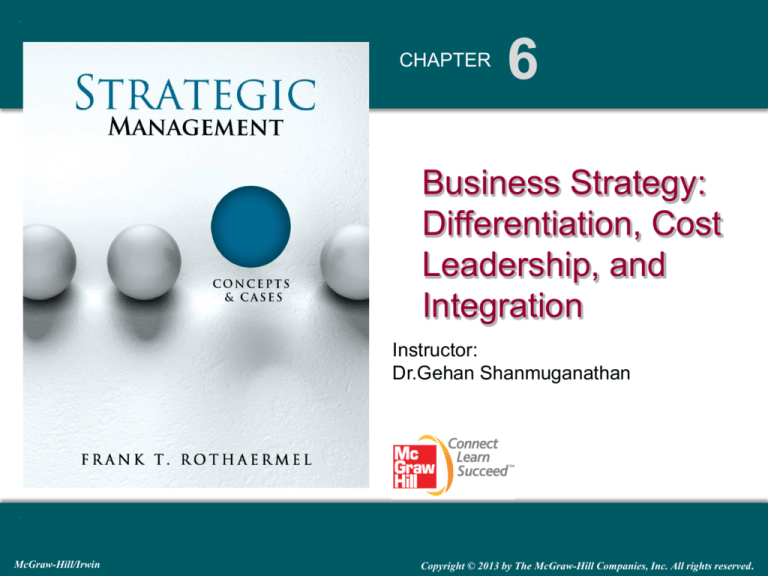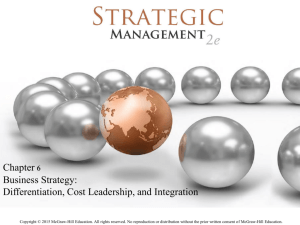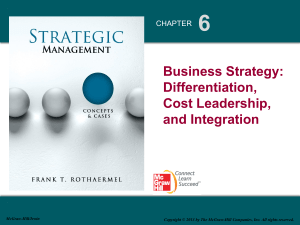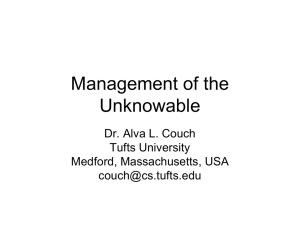
CHAPTER
6
Business Strategy:
Differentiation, Cost
Leadership, and
Integration
Instructor:
Dr.Gehan Shanmuganathan
McGraw-Hill/Irwin
Copyright © 2013 by The McGraw-Hill Companies, Inc. All rights reserved.
Part 2 Strategy Formulation
6-2
LO 6-1 Define business-level strategy and describe how it
determines a firm’s strategic position.
LO 6-2 Examine the relationship between value drivers and differentiation
strategy.
LO 6-3 Examine the relationship between cost drivers and cost-leadership
strategy.
LO 6-4 Assess the benefits and risks of cost-leadership and differentiation
business strategies vis-à-vis the five forces that shape
competition.
LO 6-5 Explain why it is difficult to succeed at an integration strategy.
LO 6-6 Evaluate value and cost drivers that may allow a firm to pursue an
integration strategy.
LO 6-7 Describe and evaluate the dynamics of competitive positioning.
6-3
ChapterCase 6 Trimming Fat at Whole Foods Market
• Whole Foods…Business Strategy Revitalization
Started as small natural-foods store 1980
Became market leader; differentiation through
organics and quality
Competitive advantage through 2008
• CEO John Mackey: Refocused Mission, Reduced Costs
6-4
Business-Level Strategy: How to Compete
for Advantage?
• Answer the “Who, What, Why, and How”
Who - which customer segments to serve?
What needs, wishes, desires will we satisfy?
Why do we want to satisfy them?
How will we satisfy customers’ needs?
• Details actions managers take in quest for
competitive advantage
Single product or group of similar products
6-5
EXHIBIT 6.1
Industry and Firm Effects Jointly
Determine Competitive Advantage
6-6
Strategic Position
• Determined by Firm’s Business-Level Strategy
Two primary competitive levers:
Value (V)
Cost (C)
• Economic Value Created: (V-C)
The greater (V-C) = Competitive Advantage
• Strategic Position Based on:
Value creation
Cost
6-7
EXHIBIT 6.2 Strategic Position and Competitive Scope:
Generic Business Strategies
6-8
Value Drivers
• Product Features
• Customization
Most important &
Tailoring for specific
clearest drivers
Unique product
features>> higher price
customers
“Mass customization”
Threadless T-shirts
BMW M3
• Customer Service
ID unmet customer
needs & satisfy them
Zappos online retailer
Toyota Lexus brand
• Complements
Add value when
consumed in tandem
DVR (i.e., Tivo)
6-9
STRATEGY HIGHLIGHT 6.1
Toyota: From “Perfect Recall”
to “Recall Nightmare”
• Toyota’s strategic challenges….
Launched Lexus 1989
Luxury car segment dominated by Mercedes-Benz, BMW, Cadillac
LS400 line required recall a little over a year after launch
Turned threat into opportunity to establish reputation for superior
customer service
Two years after launch Lexus ranked first on quality and customer
satisfaction by J.D. Powers
2010 Toyota has largest recall in automotive history
Needed to exhibit superior customer responsiveness again
8 million vehicles recalled was much more challenging
1–10
6-10
EXHIBIT 6.4
Cost Drivers: Cost-Leadership
• Cost Leadership:
Cost of input factors, economies of scale, and learning-curve and
experience-curve effects
Competitive advantage = economic value created (V-C) > competitors
Walmart vs. Kmart
Dell vs. Compaq, Gateway, & HP
6-11
INTEGRATION STRATEGY: COST LEADERSHIP
AND DIFFERENTIATION
• Trade-offs between low cost & differentiation
• Value & Cost Drivers of Integration
Quality
Can increase perceived value & lower cost (V-C)
Economies of Scope
Starbucks adding hot tea to its menu
Innovation
IKEA - stylist furniture in flat pack delivery
Structure, Culture, & Routines
Ambidextrous organization – explore AND exploit
Intel current and future products and services
6-12
EXHIBIT 6.9
Value and Cost Drivers
6-13
The Dynamics of Competitive Positioning:
Apple, HP, and Dell
EXHIBIT 6.10
6-14
CHAPTERCASE 6 Consider This…
• Whole Foods continues to seek ways to differentiate
2010 enhanced its “back to school” program
300 salad bars in public schools within 50-mile radius of any Whole
Foods store
2011 expanded to 500 elementary, middle, and high schools
across the U.S.
Expanding in-store educational efforts with “wellness clubs”
1. What value drivers is Whole Foods using to remain differentiated
in the face of Walmart and others now selling organic foods?
2. Given the discussion in the ChapterCase about Whole Foods
trimming its cost structure, does the firm risk being “stuck in the
middle”? Why or why not?
3. What other methods could Whole Foods use to successfully drive
its business strategy?
Whole Foods – John Mackey Video
6-15








